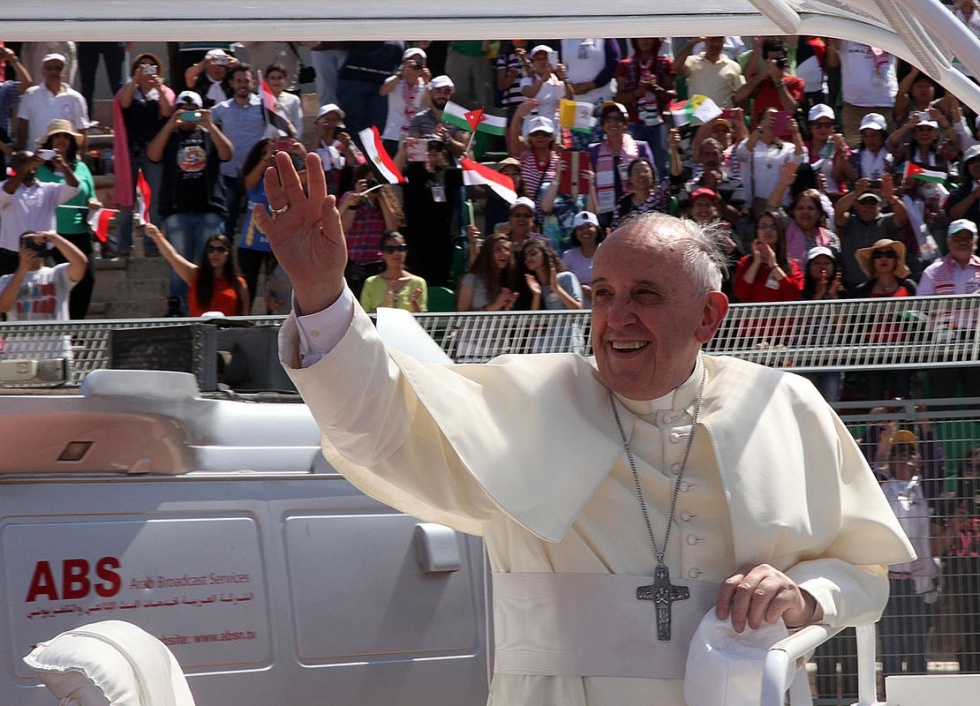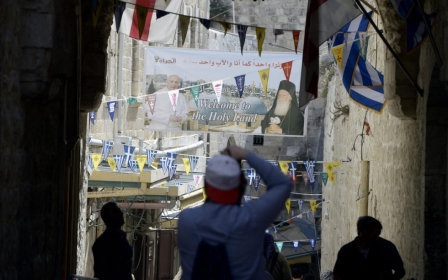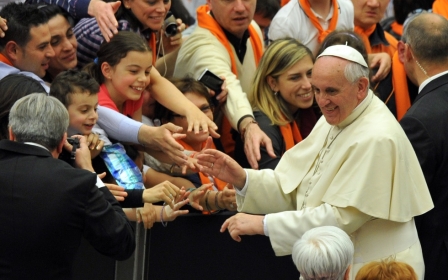Pope invites presidents of Israel and Palestine to Vatican City

Pope Francis has invited Palestinian president Mahmoud Abbas and his Israeli counterpart Shimon Peres to join him in the Vatican City on 6 June to "pray for peace", as his Middle East trip continues in Israel on Sunday.
Abbas has accepted the invitation, according to negotiator Saeb Erekat who spoke to the AFP, and although Peres welcomed the invitation he has not explicitly said he will attend as yet.
Arriving at Ben Gurion Airport in Tel Aviv on Sunday, Francis expressed his sorrow at a shooting in Brussels that left four people, including two Israelis, dead.
"I am profoundly saddened, my thoughts go out to those who lost their lives in the attack in Brussels," the 77-year-old pontiff said of the attack that is suspected to have been motivated by anti-Semitism.
Earlier, Pope Francis made an unscheduled stop at Israel's towering West Bank separation wall in Bethlehem Sunday after calling for an end to the "increasingly unacceptable" Israeli-Palestinian conflict.
The pope has said his three-day visit to the Middle East, which began in Jordan Saturday, has "purely religious" motives, but Palestinians hoped he would show support for statehood, weeks after the collapse of US-brokered peace talks with the Israelis.
Francis will continue his visit with a trip to Jerusalem later Sunday and meetings with Israeli leaders.
He flirted with the region's sensitive politics when he climbed out of his white, open jeep in Bethlehem as his convoy passed near the controversial separation wall erected by the Israelis.
Dressed in his white cassock and flanked by anxious Palestinian security guards, he walked over to the eight-metre high concrete barrier, which is topped by a guard tower.
Bowing his head in silent prayer, he paused for several minutes in front of the graffiti-daubed wall, his palm resting against the concrete.
"Pope we need to see someone to speak about justice. Bethlehem look like Warsaw ghetto. Free Palestine," read the graffiti in English, scrawled over the wall that had been painted by the Israelis only on Friday.
The unexpected stop came as the pope, who is on a three-day visit to the Middle East, was on his way to celebrate mass with 10,000 pilgrims in a packed and colourful Manger Square, next to the site Christians revere as the birthplace of Jesus.
His arrival in the West Bank early Sunday marked the start of the second stage of his brief tour aimed at easing an ancient rift with Orthodox Christians and speaking out in favour of regional peace.
Looking tired as he arrived from Jordan by helicopter, the pope received a red carpet welcome from local officials and priests.
Palestinian president Mahmoud Abbas received him at his palace with a warm embrace.
Abbas raised the thorny subject of Jerusalem - claimed both by Israel and the Palestinians as their capital - accusing Israel of "systematically acting to change its identity and character, and strangling the Palestinians, both Christians and Muslims, with the aim of pushing them out."
'Strangling Jerusalem'
Francis did not mince words in his speech, as he called for peace.
"The time has come to put an end to this situation which has become increasingly unacceptable," he said.
"The time has come for everyone to find the courage... to forge a peace which rests on the acknowledgement by all of the right of two states to exist and to live in peace and security within internationally recognised borders."
Israel began building a vast barrier through the West Bank in 2002 at the height of the second Palestinian intifada, or uprising, saying its construction was crucial for security.
But the Palestinians see the barrier, two thirds of which is located in the West Bank, as a land grab aimed at stealing part of their future state.
A Christmas welcome
Arriving in Manger Square, Francis was greeted by a choir singing the Christmas carol "Angels from the Realms of Glory."
Since dawn, Catholic pilgrims had filed past security barriers into the square. The scene was dominated by stage where the pope celebrated mass, decked with huge Palestinian and Vatican flags and adorned with a giant tableau depicting the birth of Jesus.
The Vatican said the main reason for the visit was a meeting in Jerusalem with Bartholomew I, the Orthodox Patriarch of Constantinople, seeking to heal a nearly 1,000-year rift between the Orthodox and Roman Catholic churches.
Meanwhile, in Jerusalem, police arrested 26 Jewish extremists protesting at a site on Mount Zion where the pope will celebrate mass on Monday.
Ahead of the Pope Francis's visit to Israel later Sunday, Israeli Prime Minister Netanyahu hailed the pope's "determined stance" against anti-Semitism, a day after a shooting attack on the Jewish Museum in Brussels killed three people, two of them Israelis.
"We appreciate the pope's determined stance against anti-Semitism, especially in light of the growing hatred of Jews that we are witness to in these days," Netanyahu said at the start of his weekly cabinet meeting.
'Charm offensive'
"Francis comes in with a lot of political capital. He's sort of a new Nelson Mandela, a new moral authority on the world stage," said John Allen, Vatican expert for the Boston Globe.
"The question is: can he spend that moral capital to shame both sides into talking to each other?"
US-led peace talks between Israeli and Palestinian negotiators collapsed last month amid bitter recriminations, ending a nine-month bid to reach a solution, with no political initiative on the horizon.
The pope was to have lunch with several Palestinian families then meet with refugee children at the entrance to Dheishe refugee camp.
During the afternoon, he will take a short flight to Tel Aviv where he will be formally welcomed to Israel by President Shimon Peres before flying on to Jerusalem.
Middle East Eye propose une couverture et une analyse indépendantes et incomparables du Moyen-Orient, de l’Afrique du Nord et d’autres régions du monde. Pour en savoir plus sur la reprise de ce contenu et les frais qui s’appliquent, veuillez remplir ce formulaire [en anglais]. Pour en savoir plus sur MEE, cliquez ici [en anglais].




